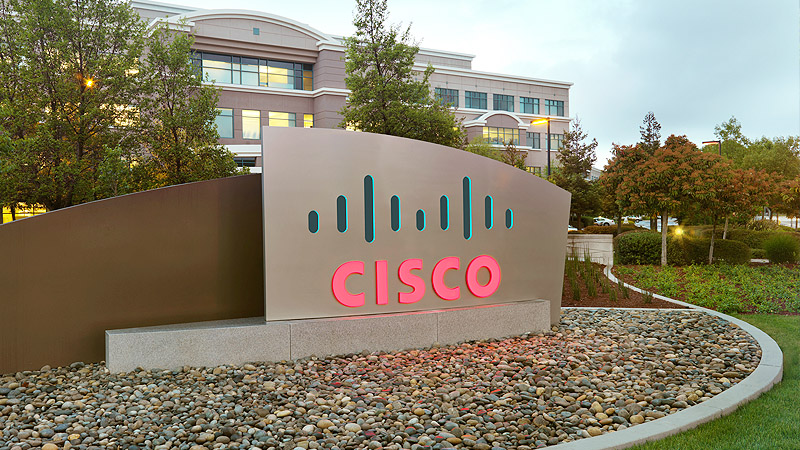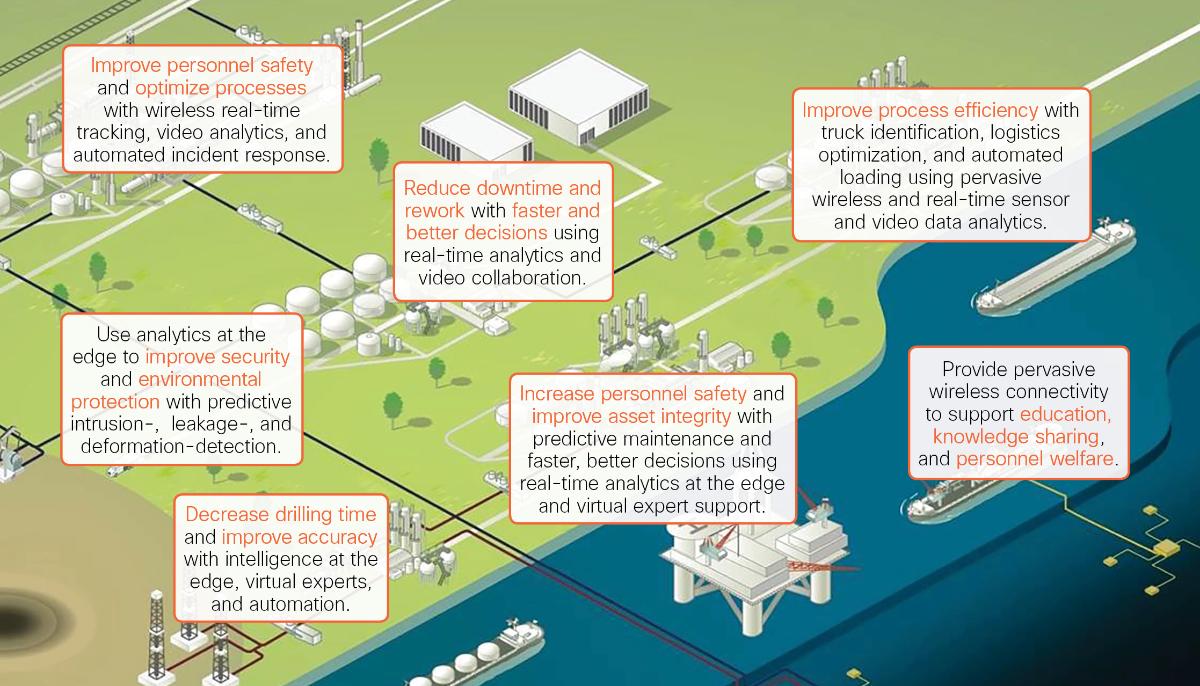- For a $50 billion O&G firm, increased IoE adoption translates into an 11 percent bottom-line (EBIT) improvement. For the entire industry, increased IoE adoption generates $600 billion in Value at Stake.
- 14-country survey reveals that oil and gas professionals believe “operational efficiency of existing projects” and “maintenance of assets and infrastructure” are their top two areas of increased investment over the next 24 months.
Worldwide oil production is outpacing demand, and oil prices have fallen by more than 50 percent since June 2014. Many factors — including soft demand, increasing U.S. production and diminishing storage for crude oil — suggest that the days of $100-a-barrel oil may not return. This scenario presents potentially disastrous consequences for oil and gas (O&G) firms that are not prepared to accelerate their digital transformation. Innovative oil and gas firms, however, believe today’s turbulent market landscape provides an opportunity to grab competitive advantage by harnessing new technologies.
Cisco® Consulting Services conducted a survey that uncovers the urgency for the oil and gas industry to adopt digital technologies powered by the Internet of Everything (IoE) — the networked connection of people, process, data, and things — to stay competitive. The survey identified intelligence from data as the key area needed to improve operational efficiency, and data analytics as the No. 1 IoE driver for faster, better decision-making.
Industry Adoption of IoE Could Increase Global GDP by Up to 0.8% – or $816 billion
To calculate this number, Oxford Economics began by incorporating into its Global Economic Model Cisco’s $600 billion IoE Value at Stake estimate for the oil and gas industry over the next decade (including productivity gains, reduced OpEx and CapEx, and IoE adoption cost of $180 billion).
This estimate is based on both increased supply and greater demand, resulting in a “positive supply shock” for the global economy. Lower oil prices stimulate more spending on goods and services, with most of the gains being realized through the consumer sector. Oxford also projects that global consumer spending could be up to 1.5% higher than the base-case forecast by 2025. This aggregate increase includes a “second round impact” of higher economic activity, raising overall employment (and decreasing unemployment) around the globe.
Digital Transformation: $538 Million Annual Profit Increase for a $50 Billion O&G Company
Cisco Consulting Services estimates that this IoE-driven value will come from improvements in asset utilization, process or supply chain efficiency, employee productivity, CapEx savings, and market innovations. For a midsize oil and gas company with $50 billion in annual revenue, IoE can generate a $538 million annual profit increase and an 11% bottom-line (EBIT) improvement. 72% of these benefits are derived from cost reduction, while the remaining 28% are from increased revenues.
Key Findings
Cisco’s survey respondents named “operational efficiency of existing projects or reserves” and “maintenance of assets and infrastructure” as their top two areas of increased investment over the next 24 months. Leaders must improve operational efficiencies and asset life to stay competitive without cutting costs through layoffs and project cancellations.
While survey respondents understand that connecting “things” is a necessity, true value lies in the intelligence of extracted and analyzed data from the “things”. This intelligence allows oil and gas firms to drive business and operational transformation.
48% of respondents named “data” as the area of IoE they need to improve most to make the most effective use of connected technologies (IoE).
Effective data management and analytics can generate operational and business benefits: Offshore oil platforms generate between 1TB and 2TB of time-sensitive data per day.1 Slow satellite communication is the most common link to transmit this data, requiring over 12 days to move one day’s worth of oil-platform data to a central repository such as the cloud. An effective data strategy involves being able to automatically detect whether the data needs to be sent to the cloud for analysis, or whether it should be analyzed at the “edge” of the network, where the data is collected (e.g., from sensors on drilling equipment). Edge analytics allow O&G companies to gain greater real-time insight, thus providing specific business and operational advantages.
- Survey respondents ranked “faster problem resolution” as the No. 1 business benefit of connected technologies (IoE), while “improved production efficiency” was the top operational benefit.
- Respondents believe IoE will boost operational efficiencies primarily in the upstream segment of the value chain, naming “production” as the No. 1 beneficiary.
Automation and Business Process: Analytics-driven insights will drive the opportunity for process change and optimization.
- More than half of respondents believe IoE has the potential to automate anywhere from 25 percent to nearly 50 percent of manual processes. .
- “Production optimization” was identified by 56% of respondents as the process with most IoE-driven automation benefits, ahead of “Maintenance” and “Business Operations.”
Security: Protection of company information (including customer, transactional, and geological data) was identified as the chief security concern. The Department of Homeland Security stated that 53% of all cybersecurity incidents in the six months ending in May 2013 occurred in the energy sector, and the number of attacks is increasing.
- “Process control systems” was the second-biggest security concern, followed by “IT systems.”
IT and OT Convergence: Effective IT–OT convergence can optimize business processes, enhance information for better decisions, reduce costs, lower risks, and shorten project timelines.
- O&G companies need to make improvements in this regard: 59% of survey respondents do not believe that their firms’ IT and OT strategies are aligned.
QUOTES:
“Cisco Consulting Services estimated that the adoption cost of the Internet of Everything would be about $180 billion for the industry. Over a 10-year period, the multiplier impact would be about three to four times when it's translated to the global economy. That's quite a positive multiplier impact.”
—Kathy Bostjancic, Director, U.S. Macro Investor Services, Oxford Economics
“For the first time, pressure is being brought to bear on organizations across the globe to re-engineer the way they do things, and that requires a lot of thought. It requires the bringing together of technology and people… If the going gets tough in the industry and you are looking to make cost savings, you will want remote monitoring and remote operation, which is going to require an awful lot of information traffic — intelligent, real-time diagnostics, and then intervention.”
—Graham Hill, EVP, Global Business Development & Strategy, KBR, Inc.
1 “Internet of Things Technologies Could Transform Oil, Gas Industry,” Karen Boman, Rigzone, September 1, 2014.
Additional Study Resources
- Read the full report: A New Reality For Oil&Gas
- Video Playlist: Thought Leader Interview Series
- Infographic: How Digital Transformation in Oil&Gas Can Fuel Global GDP
- Image: View of Digital Transformation in Oil&Gas
Cisco Oil&Gas and Internet of Everything
- Learn more about Cisco Oil&Gas
- Connect with Cisco at CeraWeek 2015
- Follow Cisco’s IoE Story with Joseph Bradley
- Explore the Internet of Everything
- Join the Conversation #InternetOfEverything
About Cisco
Cisco (NASDAQ: CSCO) is the worldwide leader in IT that helps companies seize the opportunities of tomorrow by proving that amazing things can happen when you connect the previously unconnected. For ongoing news, please go to http://thenetwork.cisco.com.










